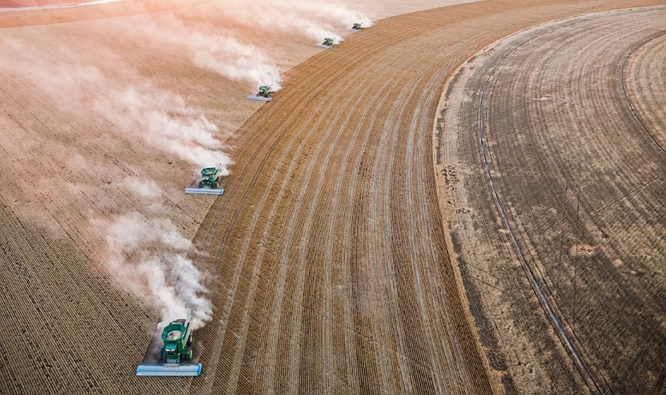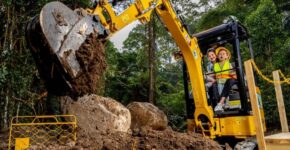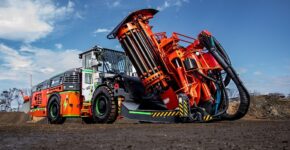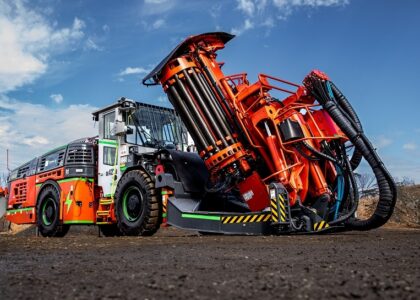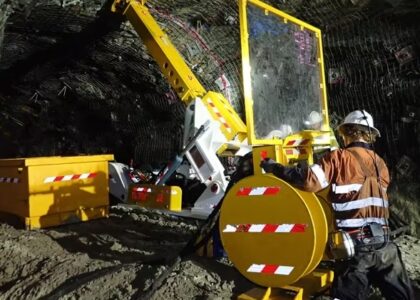While the large tires of giant combines may prevent them from sinking into the fields, their immense weight still exerts excessive pressure on the soil, leading to its compaction and ultimately diminishing the soil’s vitality. This could have significant repercussions on global crop yields.
When engaging in discussions about farm machinery with experts like Thomas Keller or Dani Or, it’s not uncommon for the conversation to take an unexpected turn towards dinosaurs. Why would biologists and soil structure specialists transition from talking about tractors and combines to extinct giants? The reason, as they highlight in a recent paper, is that modern-day farm vehicles have reached weights comparable to those of the largest creatures to ever roam the Earth. Unfortunately, this excessive weight is causing significant damage to one of our planet’s most valuable resources: fertile soil. Dani Or, who divides his time between the Desert Research Institute in Reno, Nevada, and the Swiss Federal Institute of Technology in Zurich, states:
“It’s not rocket science. We have witnessed a consistent escalation in the size of farm machinery for over a century. It is inevitable that repercussions will follow.”
The trend towards larger and heavier farm machinery has become particularly prominent in the past 60 years. Keller and Or’s research reveals a striking pattern: between 1958 and 2020, the average weight of a fully loaded combine harvester used for corn or wheat has increased nearly tenfold. It has grown from approximately 8,800 pounds six decades ago to about 79,000 pounds in the present day. To put this into perspective, a fully loaded sugar beet harvester can weigh over 130,000 pounds, comparable to the weight of the colossal sauropods—the heavyweight champions of the dinosaur era. (In contrast, the weight of the largest land-dwelling animal today, the African elephant, appears rather modest at around 20,000 pounds.)
The Mounting Soil Stress Caused by Heavier Harvesters
Modern high-end harvesters now weigh approximately 8.5 times more than tractors from 1958. However, it is not just their overall weight that raises concerns. The pressure exerted by their tires on the soil layers has reached a level comparable to the immense force exerted by the feet of sauropod dinosaurs like Brontopodus. This parallel between the harvesters’ impact on soil stress and the weighty footsteps of ancient giants highlights the potential consequences of these heavy machines on our agricultural land.
“In a sense, it’s remarkable,” expresses Keller, a professor at the Swedish University of Agricultural Sciences in Uppsala. “When you compare the amount that can be harvested in a given time today with what would have been possible 60 years ago…”
Presently, certain wheat harvesters, for instance, can clear an impressive 30 acres within a single hour.
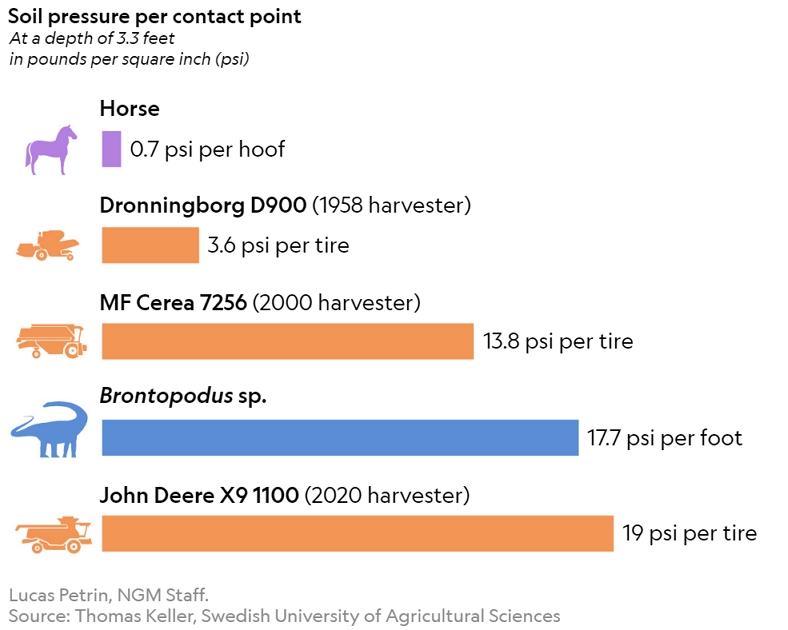
The remarkable efficiency achieved by these agricultural machines allows approximately 5 percent of the global population to provide sustenance for the remaining 95 percent. However, according to Or and Keller, this productivity comes at a significant cost to the world’s soils. Their estimation suggests that oversized agricultural machinery poses a threat to approximately 20 percent of all arable land, primarily in North America, Europe, Brazil, and Australia, where these large-scale vehicles are extensively utilized. The consequences are severe, as heavily compacted soil, once damaged, may take several decades to recover, if recovery is possible at all.
According to Or, there is evidence indicating a decline in yields despite efforts to improve wheat and other cereal crops through breeding. He notes:
“We have been consistently experiencing reduced yields, and while there may be multiple factors at play, this trend appears to be more prevalent in the mechanized world.”
A recent study revealed that soil compaction caused by heavy machinery has resulted in yield reductions of up to 50 percent in certain fields. If the current trends persist, the cumulative effects of compaction and erosion could potentially lead to a global decline in crop yields by as much as 20 percent in the future.
Unseen damage
Soil compaction is a hidden threat, often unnoticed even by farmers themselves. To mitigate its impact on the land, manufacturers have attempted to address the issue by equipping heavy vehicles with oversized tires. These large tires distribute the weight over a wider surface area, preventing the vehicles from sinking too deeply into the soil surface. This approach aims to minimize the extent of soil compaction caused by heavy machinery.
Despite the use of oversized tires, the full weight of the machines is still absorbed by the deeper layers of the soil. The compressive stress radiates outwards beneath each point of contact with the tire, and at the center, these stress lines intersect and accumulate. Visualize the tire as the base of an inverted, buried pyramid of stress: The heavier the vehicle, the deeper the apex of the pyramid penetrates into the soil, exerting greater pressure on the underlying layers.
“When you have a heavier load, the stress diminishes at a slower rate as you go deeper,” explains Keller.
For instance, a motorcycle would create a deeper track on the surface of a field compared to a tractor, but the weight of the tractor would have a more profound impact on the soil, reaching deeper layers. The wide tires of the tractor serve to distribute the impact, making it less noticeable on the surface. It’s akin to how tall smokestacks on a power plant disperse air pollution over a wider area downwind, making it less immediately apparent.
However, it is crucial to recognize that healthy soils are not just a surface-level concern; they are permeable and teeming with life, and we rely on the deep layers as well. Even a teaspoon of garden soil can harbor an astonishing billion bacteria, intricate networks of air pockets, extensive fungal filaments spanning several yards, and countless protozoa.
“Soils represent the most biodiverse ecosystems on Earth,” affirms Paul Hallett, a soil physicist at the University of Aberdeen in Scotland. “This exceptional biodiversity is primarily due to the intricate pore structure that exists within the soil.”
The weight of heavy machinery suffocates the vibrant ecosystem within the soil. While tilling can partially address the issue by aerating the upper layers of soil, it worsens erosion and fails to reach deeper depths. According to Or and Keller, modern colossal agricultural machines are compacting the soil at depths of a foot or more. This compression damages the soil’s pores, reduces oxygen levels, and disrupts the essential life forms that form the foundation for robust soils, healthy roots, and thriving crops.
“The compaction in the subsoil is irreversible and permanent,” explains Markus Berli, an environmental physicist at the Desert Research Institute.

He emphasizes that the natural processes capable of mitigating compaction are far more effective near the surface of the soil than in the deeper layers. The impact of compaction is not limited to less productive areas, as even the most fertile biomes are susceptible to its effects. In Brazil, for instance, researchers have discovered that the subsoil in a heavily logged region of the Amazon rainforest has yet to recover, even three decades after the departure of heavy logging trucks and machinery.
While the precise impact is challenging to measure, compaction of the soil has a detrimental effect on its ability to store carbon. Dense and compacted soils impede the growth of roots, which serve as vital conduits for carbon sequestration into the soil. In total, soils contain over two trillion tons of carbon, approximately three times the amount present in the atmosphere. This makes soil the largest terrestrial reservoir of carbon. As Hallett explains:
“There is more carbon beneath the ground than above it.”
Thus, the preservation and health of soil play a crucial role in maintaining a balanced carbon cycle and mitigating climate change.


